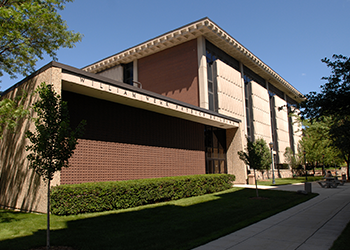Sabina Valladares (M.S. 1991 from Marquette)
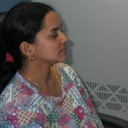 Sabina Valladares owns her own business, Advanced Circuit Engineers, in Silicon Valley. The company troubleshoots integrated circuits using a focused ion beam to modify existing circuits or to lay down pads for attaching external probes. Following graduation from Marquette, Sabina earned a M.S. in Materials Science from the University of California at San Diego in 1994, and found jobs in the disc drive industry and the semiconductor industry before starting her new business in 2004. Sabina Valladares owns her own business, Advanced Circuit Engineers, in Silicon Valley. The company troubleshoots integrated circuits using a focused ion beam to modify existing circuits or to lay down pads for attaching external probes. Following graduation from Marquette, Sabina earned a M.S. in Materials Science from the University of California at San Diego in 1994, and found jobs in the disc drive industry and the semiconductor industry before starting her new business in 2004.
Sabina says that she uses the problem-solving skills she gained in physics on a daily basis. She adds, "a Physics major prepares you for just about anything. One can work as an engineer, a chemist, a physicist, a teacher, a radiologist, do research and development, be an astronaut, etc. People from those fields cannot become physicists. But a physicist can become all those things."
Sabina advises current physics majors to seek out internships in industry. It is important to understand how physics actually gets used in a variety of settings in "the real world."
|
Michael Johnstone (B.S. 1990 from Marquette)
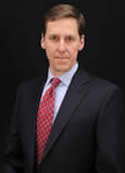 “I chose to enter Physics under the naive belief that I would have less math classes than engineering. Well, I was completely wrong, but never regretted it. I entered the Navy Nuclear Power program after college. My physics major and math minor helped me to succeed in a very challenging program.” He became a Nuclear Submarine Officer in the U.S. Navy, and also served as a Lieutenant Commander in the U.S. Naval Reserve. “I chose to enter Physics under the naive belief that I would have less math classes than engineering. Well, I was completely wrong, but never regretted it. I entered the Navy Nuclear Power program after college. My physics major and math minor helped me to succeed in a very challenging program.” He became a Nuclear Submarine Officer in the U.S. Navy, and also served as a Lieutenant Commander in the U.S. Naval Reserve.
“After I left the Navy, I have used my physics background in my civilian work life. I have worked with engineers, chemists, and physicists throughout my career. The physics background has helped me to "translate" technical ideas into business concepts and back.”
Post-Navy, Mike earned his Master of Science degree in Manufacturing and Technology Management from the University of Wisconsin – Madison in 1999. From 2000-2007, he was Global Purchasing Manager at Spectrum Brands. He then became Supply Chain Manager for four years at TomoTherapy, Inc., a manufacturer of radiation therapy machines for cancer treatment.
Mike is currently the Vice President of Purchasing & Business Integration for Stoughton Trailers, LLC in Stoughton, Wisconsin. Mike joined Stoughton Trailers as the V.P. of Purchasing in June 2011.
Originally from Land O’ Lakes, Wisconsin, Mike now resides in Madison with his wife (Karla) and their four children (Daniel, Sarah, Elizabeth, and Ian). In his free time, Mike enjoys hiking, pheasant hunting, and traveling.
|
Peter Bandettini (B.S. 1989 from Marquette)
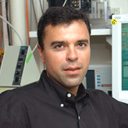 Peter Bandettini is Chief of the Section on Functional Imaging Methods at the National Institutes of Health, where he also serves as Director of the Functional Magnetic Resonance Imaging Facility. During his last two years at Marquette, he worked summers at the Institute for Pharmacology and Toxicology at the Medical College of Wisconsin and spent a semester there after graduating from Marquette in December. He considered medical school but decided on a Ph.D. in Biophysics from MCW. He took a post doc at Massachusetts General Hospital and Harvard, became an assistant professor at MCW, and then moved to NIH in 1999. He has received the NIH Scientific Director's Merit Award, and in 2002, he was awarded the Wiley Young Investigator's award at the meeting of the Organization for Human Brain Mapping. Peter Bandettini is Chief of the Section on Functional Imaging Methods at the National Institutes of Health, where he also serves as Director of the Functional Magnetic Resonance Imaging Facility. During his last two years at Marquette, he worked summers at the Institute for Pharmacology and Toxicology at the Medical College of Wisconsin and spent a semester there after graduating from Marquette in December. He considered medical school but decided on a Ph.D. in Biophysics from MCW. He took a post doc at Massachusetts General Hospital and Harvard, became an assistant professor at MCW, and then moved to NIH in 1999. He has received the NIH Scientific Director's Merit Award, and in 2002, he was awarded the Wiley Young Investigator's award at the meeting of the Organization for Human Brain Mapping.
Peter uses physics on a daily basis because his work is with resonance and electromagnetism. Imaging makes heavy use of much of the mathematics used in basic physics, especially basic Fourier transformation. He points out that a physics major is an excellent base for integrating science with other interests such as medicine.
Peter advises current physics majors to recognize that physics does much more that teach you a trade. It teaches you to approach problems and to think constructively about them.
|
Stephen Jensen (B.S. 1982 from Marquette)
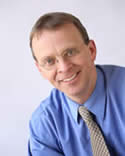 Stephen Jensen is a patent attorney and president of an intellectual property law firm in Appleton, Wisconsin called Wilhelm Law, S.C. After graduating from Marquette, Steve earned his M.S.E.E. from the University of New Mexico. From there, he worked as an R&D engineer to develop optical techniques for measuring temperature, pressure, and flow. This work brought him into contact with the company’s patent attorneys, and before long he switched from the engineering department to the legal department, attended night law school, and became a patent attorney. Stephen Jensen is a patent attorney and president of an intellectual property law firm in Appleton, Wisconsin called Wilhelm Law, S.C. After graduating from Marquette, Steve earned his M.S.E.E. from the University of New Mexico. From there, he worked as an R&D engineer to develop optical techniques for measuring temperature, pressure, and flow. This work brought him into contact with the company’s patent attorneys, and before long he switched from the engineering department to the legal department, attended night law school, and became a patent attorney.
Stephen feels indebted to his fine teachers at Marquette—including in particular the then-resident Jesuits, Fr. Frank Pedrotti, Fr. Don Matthys, and Fr. Tad Burch—for instilling in us a love of physics. He also feels fortunate and blessed that his years at Marquette, and afterward, became entwined with those of another MU physicist named Stephen – dear, intelligent, energetic, and silly (!) Stephen K. Weinreich. What began as a healthy rivalry grew into a deep friendship after a number of unlikely but providential intersections of our respective adventures. Steve Weinreich’s adventure was cut short. May he rest in peace.
Regarding advice to current physics majors, Steve would only add two seemingly unrelated footnotes to the wonderful insights provided by the other MU physics alumni here. First, try to keep in mind that as you study physics you are studying the handiwork of God. Second, try to keep, or develop, a healthy sense of humor!
|
Shaheen M. Islam (M.S. 1981 from Marquette)
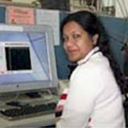 Shaheen M. Islam is professor of physics at Virginia Union University in Richmond, VA. She completed her masters thesis using Mossbauer Spectroscopy to look at magnetic transitions in ferrites at low temperature under the tutelage of Father Tad Burch, and then studied for her Ph.D. at Notre Dame. She is an active researcher using X-ray Absorption Fine Structure (XAFS) to study local structure of material. The XAFS data is collected at National Synchrotron Light Source (NSLS) at Brookhaven National Laboratory. Shaheen M. Islam is professor of physics at Virginia Union University in Richmond, VA. She completed her masters thesis using Mossbauer Spectroscopy to look at magnetic transitions in ferrites at low temperature under the tutelage of Father Tad Burch, and then studied for her Ph.D. at Notre Dame. She is an active researcher using X-ray Absorption Fine Structure (XAFS) to study local structure of material. The XAFS data is collected at National Synchrotron Light Source (NSLS) at Brookhaven National Laboratory.
Originally from Bangladesh, Shaheen came to Milwaukee with her husband, Quazi (M.S., 1980), who also wanted to study physics, when they were offered assistantships at Marquette. The same thing happened to them at Notre Dame, and they moved together to Richmond where her husband works as a research scientist for Philip Morris.
Shaheen advises physics students to "look at practical applications. An undergraduate degree in physics opens doors to many disciplines including the graduate programs in engineering."
|
Michael Cherney (B.S. 1979 from Marquette)
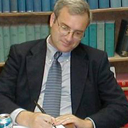 Michael Cherney is a professor of physics at Creighton University. After leaving Marquette, Mike earned his M.S. and Ph.D. from the University of Wisconsin. His dissertation was in experimental high energy physics, and he worked at both DESY and CERN. After a Post Doc at Berkeley, he moved to industry working for LeCroy. Mike's job at LeCroy was working on integrating the complex systems needed to run the L3 experiment. Michael Cherney is a professor of physics at Creighton University. After leaving Marquette, Mike earned his M.S. and Ph.D. from the University of Wisconsin. His dissertation was in experimental high energy physics, and he worked at both DESY and CERN. After a Post Doc at Berkeley, he moved to industry working for LeCroy. Mike's job at LeCroy was working on integrating the complex systems needed to run the L3 experiment.
Mike came to Creighton in 1989 and currently enjoys teaching a variety of physics courses. He is currently involved in experiments on high energy collisions of heavy nuclei at Brookhaven National Laboratory using the Relativistic Heavy Ion Collider and he is working with a group that is constructing a dedicated heavy ion detector for use with the Large Hadron Collider at CERN.
Mike reminds current physics majors, "If you want to be happy and successful, you need to be passionate about what you are doing. You'll find that you will be much more successful if you love your work!"
|
Gary A. Essman (B.S. 1969 and M.S. 1976 in physics; J.D. 1978 all from Marquette)
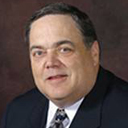 Gary A. Essman is currently a partner at the Milwaukee law firm Andrus, Sceales, Starke and Sawall, L.L.P. which specializes in intellectual property law. To practice law before the U.S. Patent Office, lawyers must pass both the regular Bar Exam and the Patent Bar Exam, which requires an undergraduate degree in science or engineering. Gary's physics degrees were essential stepping stones to his career in patent law. Gary A. Essman is currently a partner at the Milwaukee law firm Andrus, Sceales, Starke and Sawall, L.L.P. which specializes in intellectual property law. To practice law before the U.S. Patent Office, lawyers must pass both the regular Bar Exam and the Patent Bar Exam, which requires an undergraduate degree in science or engineering. Gary's physics degrees were essential stepping stones to his career in patent law.
Gary describes his work as talking to inventors and knowing enough science not to "look like a deer in the headlights" when they present technical ideas. He must then translate these ideas into the legal language needed to obtain a patent. His cases deal with electrical devices, hydraulics, light electronics, optics, and "anything mechanical." He keeps his undergraduate physics texts on a shelf in his office where they don't just collect dust, and he lends them to other lawyers in the firm.
Gary advises current physics majors to hone their writing skills. One reason some scientists have difficulty in professions like the law is that they lack the ability to present their ideas clearly and grammatically.
|
Mark O. Kaletka (B.S. 1977 from Marquette)
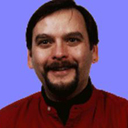 Mark O. Kaletka is Department Head of the Computing Division Core Support Services at the Fermi National Accelerator Laboratory. After graduating from Marquette, Mark earned a Masters and Ph.D. degree in nuclear physics from Northwestern University. His dissertation work was completed at Los Alamos National Laboratory in 1983, where he also worked for several years as a staff member. He moved to Boston and the MIT Laboratory for Nuclear Physics in 1984, and in 1989, he came to Fermilab. Mark O. Kaletka is Department Head of the Computing Division Core Support Services at the Fermi National Accelerator Laboratory. After graduating from Marquette, Mark earned a Masters and Ph.D. degree in nuclear physics from Northwestern University. His dissertation work was completed at Los Alamos National Laboratory in 1983, where he also worked for several years as a staff member. He moved to Boston and the MIT Laboratory for Nuclear Physics in 1984, and in 1989, he came to Fermilab.
As a nuclear physicist, Mark found that he enjoyed working with computers. In fact, he worked as an undergraduate in Marquette's first computer center that opened when he was a freshman. He uses analytical skills honed in physics on a daily basis because, he says, "Physics gives you a way of thinking about problems that applies broadly."
Mark advises current physics majors to take a business course or two. In large experimental groups, physicists need skills in managing large budgets, team building and managing people. They will be far more apt to succeed if they have some formal training in these areas.
|
George W. Kutner (B.S. 1969 from Marquette)
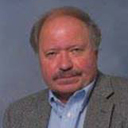 George W. Kutner is Associate Professor and former chair of the Finance Department in the College of Business Administration at Marquette. He earned an M.S. in Physics, as well as an MBA from Indiana University after discovering that finance interested him because it used mathematical models. After working as a financial analyst and a corporate planner, he returned to academia and finished a Ph.D. in Finance at Northwestern University in 1983. He taught at Michigan State from 1981 to 1985 before returning to Marquette and his family in Milwaukee. George W. Kutner is Associate Professor and former chair of the Finance Department in the College of Business Administration at Marquette. He earned an M.S. in Physics, as well as an MBA from Indiana University after discovering that finance interested him because it used mathematical models. After working as a financial analyst and a corporate planner, he returned to academia and finished a Ph.D. in Finance at Northwestern University in 1983. He taught at Michigan State from 1981 to 1985 before returning to Marquette and his family in Milwaukee.
George points out that the modeling techniques used in financial predictions are very similar to those used in physics. Physics majors are much better equipped to grapple with complex mathematical models now used in finance than are students who have not been required to describe the world around them in terms of math. Besides, George points out, "People generally think highly of people who have studied physics."
George advises current physics majors to keep physics and mathematics in perspective and to remember that it is better to keep an eye on the big picture than focus too intently on the details. In other words, when you solve the Schrodinger equation for an oddly behaved potential, you should know why you're doing it. After all, to make big breakthroughs, you have to look at big questions.
|
Paul Miller (B.S. 1963 from Marquette)
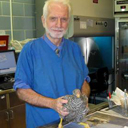 Paul Miller says that, "Physics and math are your 'go anywhere' fields," and he has used them to build an unusually productive and varied career. Today he is veterinarian working for the state of Pennsylvania doing diagnostic work on birds, a job which puts him on the cutting edge of tracking such plagues as West Nile virus and Avian Flu. Paul Miller says that, "Physics and math are your 'go anywhere' fields," and he has used them to build an unusually productive and varied career. Today he is veterinarian working for the state of Pennsylvania doing diagnostic work on birds, a job which puts him on the cutting edge of tracking such plagues as West Nile virus and Avian Flu.
After graduating from Marquette, Paul attended graduate school at Case Institute of Technology and received a Ph.D. in math in 1968. He spent the next six years in Oklahoma teaching math at Oklahoma State University and Langston University. He then came home to Milwaukee, where he joined Burroughs Corporation to help market their new computers, and then returned to academia teaching math and computer science at the University of Wisconsin - Whitewater in 1976.
He returned to Oklahoma in 1981, where his long-standing interest in birds landed him a job at the zoo. In 1982, he found a job teaching math and computer science at Central State University, and in 1988, he left to enter vet school at Oklahoma State.
Paul credits Professor Arpad Elo at Marquette for teaching him how to reach a bedrock understanding of a problem and Professor Frank Karioris for teaching him lab techniques. He advises physics students to "Learn as much as you can. Enjoy as much as you can. It will take you a long way."
|


 Sabina Valladares owns her own business, Advanced Circuit Engineers, in Silicon Valley. The company troubleshoots integrated circuits using a focused ion beam to modify existing circuits or to lay down pads for attaching external probes. Following graduation from Marquette, Sabina earned a M.S. in Materials Science from the University of California at San Diego in 1994, and found jobs in the disc drive industry and the semiconductor industry before starting her new business in 2004.
Sabina Valladares owns her own business, Advanced Circuit Engineers, in Silicon Valley. The company troubleshoots integrated circuits using a focused ion beam to modify existing circuits or to lay down pads for attaching external probes. Following graduation from Marquette, Sabina earned a M.S. in Materials Science from the University of California at San Diego in 1994, and found jobs in the disc drive industry and the semiconductor industry before starting her new business in 2004. “I chose to enter Physics under the naive belief that I would have less math classes than engineering. Well, I was completely wrong, but never regretted it. I entered the Navy Nuclear Power program after college. My physics major and math minor helped me to succeed in a very challenging program.” He became a Nuclear Submarine Officer in the U.S. Navy, and also served as a Lieutenant Commander in the U.S. Naval Reserve.
“I chose to enter Physics under the naive belief that I would have less math classes than engineering. Well, I was completely wrong, but never regretted it. I entered the Navy Nuclear Power program after college. My physics major and math minor helped me to succeed in a very challenging program.” He became a Nuclear Submarine Officer in the U.S. Navy, and also served as a Lieutenant Commander in the U.S. Naval Reserve. Peter Bandettini is Chief of the Section on Functional Imaging Methods at the National Institutes of Health, where he also serves as Director of the Functional Magnetic Resonance Imaging Facility. During his last two years at Marquette, he worked summers at the Institute for Pharmacology and Toxicology at the Medical College of Wisconsin and spent a semester there after graduating from Marquette in December. He considered medical school but decided on a Ph.D. in Biophysics from MCW. He took a post doc at Massachusetts General Hospital and Harvard, became an assistant professor at MCW, and then moved to NIH in 1999. He has received the NIH Scientific Director's Merit Award, and in 2002, he was awarded the Wiley Young Investigator's award at the meeting of the Organization for Human Brain Mapping.
Peter Bandettini is Chief of the Section on Functional Imaging Methods at the National Institutes of Health, where he also serves as Director of the Functional Magnetic Resonance Imaging Facility. During his last two years at Marquette, he worked summers at the Institute for Pharmacology and Toxicology at the Medical College of Wisconsin and spent a semester there after graduating from Marquette in December. He considered medical school but decided on a Ph.D. in Biophysics from MCW. He took a post doc at Massachusetts General Hospital and Harvard, became an assistant professor at MCW, and then moved to NIH in 1999. He has received the NIH Scientific Director's Merit Award, and in 2002, he was awarded the Wiley Young Investigator's award at the meeting of the Organization for Human Brain Mapping. Stephen Jensen is a patent attorney and president of an intellectual property law firm in Appleton, Wisconsin called Wilhelm Law, S.C. After graduating from Marquette, Steve earned his M.S.E.E. from the University of New Mexico. From there, he worked as an R&D engineer to develop optical techniques for measuring temperature, pressure, and flow. This work brought him into contact with the company’s patent attorneys, and before long he switched from the engineering department to the legal department, attended night law school, and became a patent attorney.
Stephen Jensen is a patent attorney and president of an intellectual property law firm in Appleton, Wisconsin called Wilhelm Law, S.C. After graduating from Marquette, Steve earned his M.S.E.E. from the University of New Mexico. From there, he worked as an R&D engineer to develop optical techniques for measuring temperature, pressure, and flow. This work brought him into contact with the company’s patent attorneys, and before long he switched from the engineering department to the legal department, attended night law school, and became a patent attorney. Shaheen M. Islam is professor of physics at Virginia Union University in Richmond, VA. She completed her masters thesis using Mossbauer Spectroscopy to look at magnetic transitions in ferrites at low temperature under the tutelage of Father Tad Burch, and then studied for her Ph.D. at Notre Dame. She is an active researcher using X-ray Absorption Fine Structure (XAFS) to study local structure of material. The XAFS data is collected at National Synchrotron Light Source (NSLS) at Brookhaven National Laboratory.
Shaheen M. Islam is professor of physics at Virginia Union University in Richmond, VA. She completed her masters thesis using Mossbauer Spectroscopy to look at magnetic transitions in ferrites at low temperature under the tutelage of Father Tad Burch, and then studied for her Ph.D. at Notre Dame. She is an active researcher using X-ray Absorption Fine Structure (XAFS) to study local structure of material. The XAFS data is collected at National Synchrotron Light Source (NSLS) at Brookhaven National Laboratory. Michael Cherney is a professor of physics at Creighton University. After leaving Marquette, Mike earned his M.S. and Ph.D. from the University of Wisconsin. His dissertation was in experimental high energy physics, and he worked at both DESY and CERN. After a Post Doc at Berkeley, he moved to industry working for LeCroy. Mike's job at LeCroy was working on integrating the complex systems needed to run the L3 experiment.
Michael Cherney is a professor of physics at Creighton University. After leaving Marquette, Mike earned his M.S. and Ph.D. from the University of Wisconsin. His dissertation was in experimental high energy physics, and he worked at both DESY and CERN. After a Post Doc at Berkeley, he moved to industry working for LeCroy. Mike's job at LeCroy was working on integrating the complex systems needed to run the L3 experiment. Gary A. Essman is currently a partner at the Milwaukee law firm Andrus, Sceales, Starke and Sawall, L.L.P. which specializes in intellectual property law. To practice law before the U.S. Patent Office, lawyers must pass both the regular Bar Exam and the Patent Bar Exam, which requires an undergraduate degree in science or engineering. Gary's physics degrees were essential stepping stones to his career in patent law.
Gary A. Essman is currently a partner at the Milwaukee law firm Andrus, Sceales, Starke and Sawall, L.L.P. which specializes in intellectual property law. To practice law before the U.S. Patent Office, lawyers must pass both the regular Bar Exam and the Patent Bar Exam, which requires an undergraduate degree in science or engineering. Gary's physics degrees were essential stepping stones to his career in patent law. Mark O. Kaletka is Department Head of the Computing Division Core Support Services at the Fermi National Accelerator Laboratory. After graduating from Marquette, Mark earned a Masters and Ph.D. degree in nuclear physics from Northwestern University. His dissertation work was completed at Los Alamos National Laboratory in 1983, where he also worked for several years as a staff member. He moved to Boston and the MIT Laboratory for Nuclear Physics in 1984, and in 1989, he came to Fermilab.
Mark O. Kaletka is Department Head of the Computing Division Core Support Services at the Fermi National Accelerator Laboratory. After graduating from Marquette, Mark earned a Masters and Ph.D. degree in nuclear physics from Northwestern University. His dissertation work was completed at Los Alamos National Laboratory in 1983, where he also worked for several years as a staff member. He moved to Boston and the MIT Laboratory for Nuclear Physics in 1984, and in 1989, he came to Fermilab. George W. Kutner is Associate Professor and former chair of the Finance Department in the College of Business Administration at Marquette. He earned an M.S. in Physics, as well as an MBA from Indiana University after discovering that finance interested him because it used mathematical models. After working as a financial analyst and a corporate planner, he returned to academia and finished a Ph.D. in Finance at Northwestern University in 1983. He taught at Michigan State from 1981 to 1985 before returning to Marquette and his family in Milwaukee.
George W. Kutner is Associate Professor and former chair of the Finance Department in the College of Business Administration at Marquette. He earned an M.S. in Physics, as well as an MBA from Indiana University after discovering that finance interested him because it used mathematical models. After working as a financial analyst and a corporate planner, he returned to academia and finished a Ph.D. in Finance at Northwestern University in 1983. He taught at Michigan State from 1981 to 1985 before returning to Marquette and his family in Milwaukee. Paul Miller says that, "Physics and math are your 'go anywhere' fields," and he has used them to build an unusually productive and varied career. Today he is veterinarian working for the state of Pennsylvania doing diagnostic work on birds, a job which puts him on the cutting edge of tracking such plagues as West Nile virus and Avian Flu.
Paul Miller says that, "Physics and math are your 'go anywhere' fields," and he has used them to build an unusually productive and varied career. Today he is veterinarian working for the state of Pennsylvania doing diagnostic work on birds, a job which puts him on the cutting edge of tracking such plagues as West Nile virus and Avian Flu.